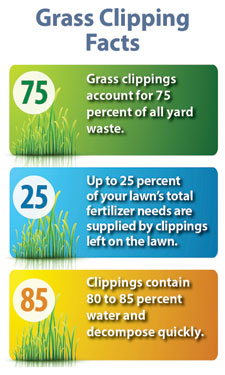 What is grasscycling? Grasscycling is the natural recycling of grass by leaving clippings on the lawn after mowing. Grass clippings decompose quickly, returning valuable nutrients back into the soil.
What is grasscycling? Grasscycling is the natural recycling of grass by leaving clippings on the lawn after mowing. Grass clippings decompose quickly, returning valuable nutrients back into the soil.
Grasscycling is great for your lawn on a number of levels. Whether you are mulching leaves or returning lawn clippings back into the lawn, mulching saves time, money and labor, and is a great soil amendment. There is really no need for raking, bagging or hauling away either leaves or clippings.
Grasscycling Benefits
You can save one-third of your annual lawn care time by mowing frequently and not collecting clippings. Clippings left on the lawn recycle nutrients, saving about 25 percent of your annual fertilizer costs. According to Dr. Norman Hummel Jr., turf grass specialist at Cornell University, “one ton of fresh clippings contains approximately 15 pounds of nitrogen, 2 pounds of phosphorous and 10 pounds of potassium — the three major nutrients [for sustaining plant life] — and smaller quantities of the other elements essential for plant life.”
We must stop thinking of grass clippings as “garbage.” According to a University of Connecticut research scientist, clippings left on the lawn can increase the organic content of the soil and lead to increased earthworm activity. Earthworms improve aeration and water movement through the soil, providing a better environment for plant growth. One ton of grass clippings contains more than 1,700 pounds of water. Leaving clippings on the lawn saves tax dollars spent for labor, fuel costs and dumping fees that are incurred to dispose of this moisture-laden material.
Three Key Elements to Successful Grasscycling
1) Correct blades make grasscycling easier. It is not enough to just leave the clippings on the turf and call it grasscycling. The proper blades can make a huge difference. From mulching blades to Gator blades, there are many varieties. The important, key difference is that blades must be sharpened regularly. Keep extra-sharp blades in stock and change them twice per week. This will improve your cut, double cut grass clippings and prevent tearing that leads to turf diseases.
2) Proper, balanced slow-release fertilizer should be used. Avoid quick-release fertilizers and fertilizers high in nitrogen, which is the first number posted on a fertilizer bag. A soil test should be performed every two years to determine what nutrients are lacking in the soil and to find out what the pH level is. Lime can be used to lower the pH when soils are acidic. Soils with a reaction of less than pH 7 are acidic and those with a reaction greater than pH 7 are alkaline. Most lawn grasses perform best at a reaction between pH 6.5 and pH 7. The higher the acidity of the soil, the greater the need for lime. Balanced fertilizer programs aide in grasscycling by controlling quick growth of turf.
3) Proper watering leads to healthy turf. The rule of thumb for watering an established lawn is, “water as deeply and as infrequently as possible.” Deep and infrequent irrigation stimulates root growth, resulting in healthy, drought-tolerant and pest-resistant turf. While it’s true that a deep, healthy root system produces verdant turf, rooting depth is determined primarily by genetics and soil condition — not irrigation. Turf that is too wet creates clumping and reduces the effectiveness of grasscycling.
Jeff Dajani is the owner of Ashburn, Virginia-based U.S. Lawns, which maintains the grounds at NRPA’s headquarters.

